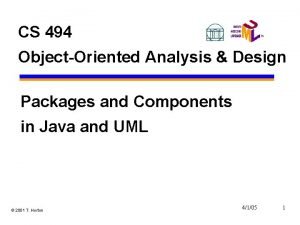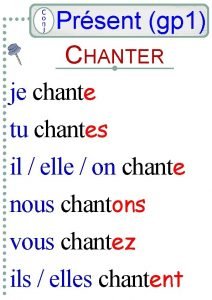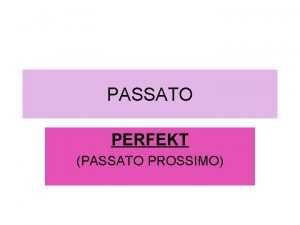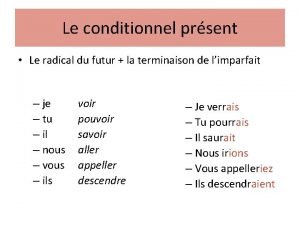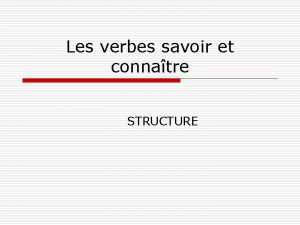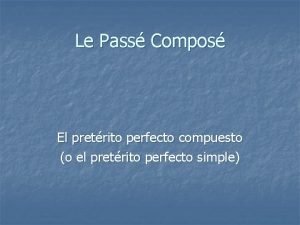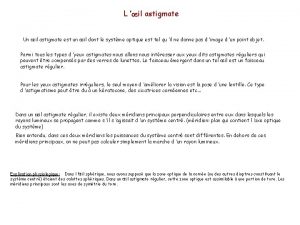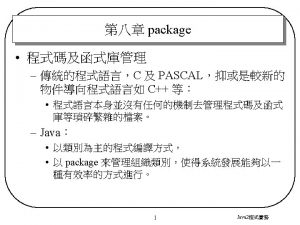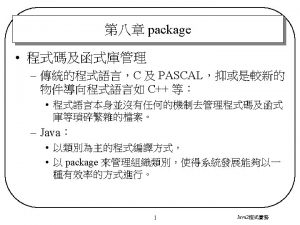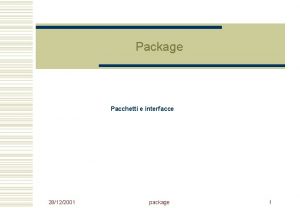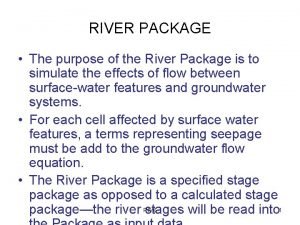Principles of Package Design COMPOSE AT A HIGHER



















































- Slides: 51

Principles of Package Design COMPOSE AT A HIGHER LEVEL OF ABSTRACTION


As applications grow in size and complexity they require some kind of high-level organization


Grouping code into packages provides two benefits • Package It allows us Coupling to reason about the design at a higher level of abstraction • Package It helps us. Cohesion manage the development and distribution of the software

What is a package? ^ Lab. VIEW

Principles of Package Design • Package Cohesion • Reuse-Release Equivalence Principle (REP) • Common-Reuse Principle (CRP) • Common-Closure Principle (CCP) • Package Coupling • Acyclic-Dependencies Principle (ADP) • Stable-Dependencies Principle (SDP) • Stable-Abstractions Principle (SAP)

Package Cohesion The three principles of package cohesion provide guidance on how to partition classes into packages

Reuse-Release Equivalence Principle “The granule of reuse is the granule of release” - Bob Martin

Reuse-Release Equivalence Principle Reusability comes only after there is a tracking system in place that offers the guarantees of notification, safety, and support

Reuse-Release Equivalence Principle What does this tell us about the internal structure of the package? • If a package contains software designed for reuse then it should not also contain software designed not for reuse • All software in a package should be reusable by the same audience

Reuse-Release Equivalence Principle Summary • Packages should be easy for users to use • Packages should be released through a tracking system • For a package to be reusable, all of its classes should be reusable

Common-Reuse Principle “The classes in a package are reused together. If you reuse one of the classes in a package, you reuse them all” - Bob Martin

Common-Reuse Principle • It is typical for classes in a package to be tightly coupled • It should be impossible to depend on some classes in a package without depending on all classes in a package

Common-Reuse Principle SRP: Classes should have only one reason to change CRP: Classes in a package should be reused together

Common-Reuse Principle Summary • Group classes according to common reuse • CRP is SRP applied to packages • Classes which are not tightly bound to each other should not be packaged together

Common-Closure Principle “The classes in a package should be closed together against the same kinds of changes” - Bob Martin

Common-Closure Principle The classes in a package should be closed together against the same kind of changes. A change that affects a package affects all the classes in that package

Common-Closure Principle The classes in a package should be closed together against the same kind of changes. A change that affects a package affects all the classes in that package

Common-Closure Principle OCP: Classes should be open for extension, but closed for modification CCP: Classes in a package should be closed to the same kinds of changes

Common-Closure Principle Summary • Packages should be closed to anticipated changes • CCP is OCP applied to packages • CCP reduces package release frequency

Package Cohesion Summary • In choosing classes to include in packages we have to balance reusability and developability • This balancing act will cause the composition of the packages to change over time • The partitioning of classes into packages cannot happen until after the classes and their interrelationships have been created • There are no metrics for package cohesion

Package Coupling The three principles of package coupling deal with the relationships between packages

Acyclic-Dependencies Principle “Allow no cycles in the packagedependency graph” - Bob Martin

Acyclic-Dependencies Principle Acyclic Dependencies Principle: The dependency structure for the package must be a Directed Acyclic Graph (DAG) where nodes are packages and edges are dependencies

Acyclic-Dependencies Principle 1 My. App 3 2 Msg. Windw 4 Task. Windw My. Tasks 5 Database 7 Tasks 6 Windows 8 My. Dialogs

Acyclic-Dependencies Principle 1 2 3 4 5 6 7 8 1 0 1 1 1 0 0 2 0 0 0 1 0 0 3 0 0 0 1 1 1 4 0 0 1 1 5 0 0 0 0 6 0 0 0 0 7 0 0 0 0 8 0 0 0 1 0 0

Acyclic-Dependencies Principle

Acyclic-Dependencies Principle 1 My. App 3 2 Msg. Windw 4 Task. Windw My. Tasks 5 Database 7 Tasks 6 Windows 8 My. Dialogs

Acyclic-Dependencies Principle 1 2 3 4 5 6 7 8 1 0 1 1 1 0 0 2 0 0 0 1 0 0 3 0 0 0 1 1 1 4 0 0 1 1 5 0 0 0 0 6 0 0 0 0 7 0 0 0 0 8 1 0 0

Acyclic-Dependencies Principle How do we break the cycle? • Dependency Inversion Principle • Create a new package and move dependent classes into the new package

Acyclic-Dependencies Principle Class X My. Dialogs Class X Class i. Y Class Y My. App Class Y

Acyclic-Dependencies Principle 1 My. App 3 2 Msg. Windw 4 Task. Windw My. Tasks 5 Database 7 Tasks 8 My. Dialogs 6 Windows new. Pckg

Acyclic-Dependencies Principle Summary • Dependency graphs should be acyclic • Cycles can be measured using DFS • Cycles can be removed through dependency inversion

Stable-Dependencies Principle “Depend in the direction of stability” - Bob Martin

Stable-Dependencies Principle Change is inevitable, we can use the Common-Closure Principle (CCP) to create packages that are sensitive to certain kinds of changes

Stable-Dependencies Principle A package with lots of incoming dependencies is very stable because it takes a great deal of work to change it

Stable-Dependencies Principle X is responsible to these three packages X is independent X

Stable-Dependencies Principle Y is irresponsible Y is dependent Y

Stable-Dependencies Principle Stability Metrics • Ca = Afferent Coupling: Number of classes outside the package that depend on classes inside • Ce = Efferent Coupling: Number of classes inside the package that depend on classes outside • I = Instability = Ce / (Ca + Ce)

Stable-Dependencies Principle A Q B R S C Package C Metrics D T U V Ca = 3 Ce = 1 I = 1/4

Demo: Package Metrics

Stable-Dependencies Principle Summary • Responsible, dependent packages are stable • We can calculate Instability • Not all packages should be stable, if they were the system would be unchangeable

Stable-Abstractions Principle “A package should be as abstract as it is stable” - Bob Martin

Stable-Abstractions Principle A stable package should be abstract so that its stability does not prevent it from being extended

Stable-Abstractions Principle SAP + SDP = DIP for packages SDP says that dependencies should run in the direction of stability, and SAP says that stability implies abstraction -> Dependencies run in the direction of abstraction

Stable-Abstractions Principle Measuring Abstraction Nc = Number of classes in the package Na = Number of abstract classes in the package A = Na / Nc

Stable-Abstractions Principle What is an abstract class in Lab. VIEW? Any Class with at least one abstract method?

Stable-Abstractions Principle Distance from the Main Sequence D = |A + I - 1| (0, 1) (1, 1) Zone of Pain Zone of Uselessness A (0, 0) I (1, 0)

Demo: Package Metrics

Summary • Packages provide high level organization for large Lab. VIEW applications • Package cohesion is a balance between usability and developability • Package coupling can be measured • Package design happens after classes and their interconnectedness have been created, and evolves as the application changes
 Stable abstractions principle
Stable abstractions principle Java package design
Java package design Elements of interior design ppt
Elements of interior design ppt Passe compose phrases
Passe compose phrases Passe simple etre
Passe simple etre 6a.2 the passé composé with avoir
6a.2 the passé composé with avoir Passe compose phrases
Passe compose phrases Conjugs
Conjugs Passe compose forma interrogativa
Passe compose forma interrogativa Verb play in present simple
Verb play in present simple Se lever verbe
Se lever verbe Unterschied passe compose und imparfait
Unterschied passe compose und imparfait Relation de chale
Relation de chale Composé méso
Composé méso Passe compose irregular verbs
Passe compose irregular verbs Passe compose i imperfekat
Passe compose i imperfekat Glagol aller u prezentu
Glagol aller u prezentu How to write your own parable
How to write your own parable Passe compose
Passe compose Verben pronominaux
Verben pronominaux Solide composé de 6 faces rectangulaires
Solide composé de 6 faces rectangulaires Opinion paragraphs
Opinion paragraphs Prince of philippines church music
Prince of philippines church music Imparfait
Imparfait Se laver present tense
Se laver present tense Le triangle d'or du positionnement marketing
Le triangle d'or du positionnement marketing Verbe aller examples
Verbe aller examples Ciblage indifférencié
Ciblage indifférencié Tu t'es endormi au feminin
Tu t'es endormi au feminin Garder passe compose
Garder passe compose Chanter imparfait
Chanter imparfait Etre passe simple
Etre passe simple Sing in present tense
Sing in present tense Chloé, tu 1 of 1 avec nous à la cantine?
Chloé, tu 1 of 1 avec nous à la cantine? Devoir passe compose
Devoir passe compose Come si forma il perfekt
Come si forma il perfekt Futur composé
Futur composé Composs
Composs Verbe admirer au passé composé
Verbe admirer au passé composé Verbes irréguliers définition
Verbes irréguliers définition Phrases hypothetiques
Phrases hypothetiques Le conditionnel
Le conditionnel Composition air
Composition air Les verbes pronominaux au passe compose
Les verbes pronominaux au passe compose Outlook deeplink compose
Outlook deeplink compose Verbe savoir passé composé
Verbe savoir passé composé Pass en pasado participio
Pass en pasado participio Appris passe compose
Appris passe compose Concordance des temps tableau
Concordance des temps tableau Oeil astigmate schéma
Oeil astigmate schéma Higher design and manufacture
Higher design and manufacture Is any return of graphic communication on the package
Is any return of graphic communication on the package

